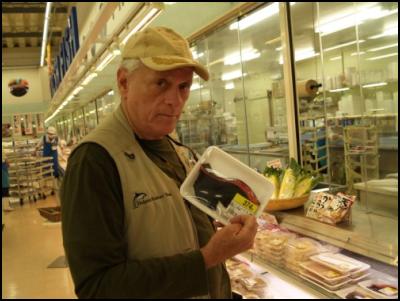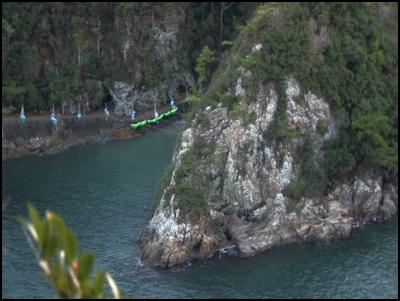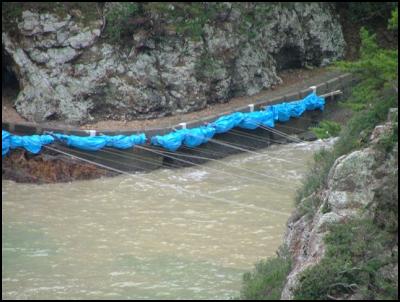Spycraft, Guts and Talent Expose The Cove
Spycraft, Guts and Talent Expose The Cove
by Rady Ananda,
radyananda.wordpress.com

From a high-tech, deep cover investigation emerges The Cove, a stunning documentary exposing the horrors of dolphin slaughter – for human consumption, despite extreme levels of mercury contamination. Dolphin activist Ric O’Barry and his crack team of world-class divers, ex-military, professional artisans and a former NatGeo photographer risk life, limb and freedom to film the action in a private cove in Taiji, Japan.
Directed by: Louie Psihoyos
Produced by: Paula
DuPré Pesmen, Fisher Stevens
An Oceanic Preservation
Society production
Written by: Mark
Monroe
Co-Producer: Olivia Ahnemann
Executive
Producer: Jim Clark
Run time: 96 minutes

Click to enlarge
“It’s all about international corporate greed and government collusion,” O’Barry told me. “The government of Japan is lying to its people.” Dolphin meat is not labeled as such, often being passed as whale meat.
Protecting corporate profits at the expense of people’s health and the environment seems to be the raison d'être for government. O’Barry warns, “This is going to be worse than the Minamata disaster.”
In Minamata, Japan, the Chisso Corporation discharged mercury into the Shiranui Sea from 1932 to 1968. Fish, the main source of protein for the 200,000 residents, became contaminated with mercury. Some reports indicate that as many as 12,000 people were affected and close to a thousand died.
People developed all sorts of neurological disorders, losing speech and coordination, and suffering convulsions. People went deaf, blind and mad. Babies were born retarded and without functioning limbs. As late as 1993, court cases were still being pursued against Chisso.
O’Barry advised, “Today’s mercury contamination is much higher than it was back then.”
Indeed, industry now contributes over 10 million pounds of mercury pollution each year, mainly from coal combustion. But other sources of mercury pollution arise from solid waste incinerators, medical and hazardous waste incinerators, cement kilns, and the manufacture of chlorine using the chlor-alkali process.
Deputy of Fisheries, Hideki Moronuki, defends Japan's dolphin slaughter as the sole livelihood of several dozen men. He submitted to mercury testing, and his hair showed mercury contamination well above the “safe” level. One scientist in the film found mercury contamination at 2,000 times the recommended safe level in the organs of dolphins.
Overhead shot of the killing cove in Taiji, Japan"

Click to enlarge
Overhead shot of the killing cove in Taiji, Japan

Click to enlarge
Closer shot of the dolphin trap with rows of nets ready to be lowered
Taiji provided free dolphin meat to schools until the team convinced two city councilmen to test the meat. They did. They found it was contaminated and immediately halted the practice. One council member removed his children from the school system.
Japan slaughters 23,000 dolphins each year. In Taiji, they capture “transient” dolphins which range 100 miles, as opposed to “residential” dolphins that range only 40 miles. Favored for dolphin shows are the bottlenose variety, as used in the 1960s TV show, Flipper.
Buyers will pay up to $150,000 per live dolphin, but they only acquire 5-10 percent of the catch. The rest is slaughtered for human consumption.
Japanese officials, including Joji Morishita, who represents Japan at the International Whaling Commission (IWC), insists the killing is humane. On film, Moronuki asserted the dolphins are killed instantly. Footage in The Cove reveals this to be patently false.
A powerful scene in the film shows Ric O’Barry with a closed circuit TV strapped to his chest as he wanders thru an IWC meeting to show people the barbaric slaughter. Moronuki’s lie cost him his job.
Still, IWC rep Morishita is pushing the IWC to fully open small cetacean hunting. Several nations have signed on with Japan, including Ecuador (despite its revolutionary Constitution protecting the Rights of Nature).
Journey into Activism
What initially motivated Flipper trainer, Ric O’Barry, was not mercury contamination. Ten years of training dolphins for Flipper taught him that these highly intelligent creatures are also sentient enough to commit suicide. After portraying Flipper for several years, Cathy swam into Ric’s arms and closed her blowhole, refusing to take another breath. A paradigm shift overtook him that guided his actions for the next 40 years.
Ric and Flipper, 1964
Ric urges people to stop visiting dolphinariums. “It’s all about demand. If there is no demand for captive dolphins, or for dolphin meat, there will be no dolphin slaughter.”
There are 200 dolphinariums around the world with Japan having the most: 36. The U.S is a close second with 32, followed by Mexico (21) and Spain (10). Japan runs three dolphin slaughters: in Taiji, Okinawa and Fuito.
Jacques Cousteau once opined: “There is about as much educational benefit to be gained in studying dolphins in captivity as there would be studying mankind by only observing prisoners held in solitary confinement.”
O’Barry concurs. “They get depressed. They get sick. These are free-ranging animals that often save humans.” One story told is by a surfer who found himself being tracked by a shark. Out of the blue (literally), a dolphin “T-boned the shark,” giving the surfer time to escape.
Marine biology students may be interested in saving dolphins, but O’Barry isn’t looking for any apprentices. One teammate was murdered in Japan, while O'Barry sat in jail. Upon his release, he learned she had been strangled.
Saving dolphins requires big heart, steady nerves and perseverance in the face of murder, arrest, corruption and government-industry collusion. Through stealth, talent and sheer tenacity, Ric O’Barry finally launches his 38-year-old campaign to ban dolphinariums with a spectacular film by the Oceanic Preservation Society.
The Cove is as exciting as any spy film. Even better, it’s real life, about real heroes, that, if effective in reaching the public, will save real humans and real animals. The cinematography is breathtaking. Be warned, though, the few minutes of “culling the pod” is as savage as seal clubbing. It reduced me to tears. But only the truth will set these intelligent, free range animals free.
What You Can Do
See the film. It opened in Los Angeles and New York City on Friday, and opens nationwide on August 7th.Don’t eat large sea creatures, including dolphins, tuna, shark and whale. Biomagnification is a process made famous by Rachel Carson in Silent Spring. Small creatures become contaminated; larger creatures eat them, collecting more toxins. Even larger creatures eat them. The higher up the food chain, the higher the level of contamination.
Visit Ric O’Barry’s Save the Dolphins website, and write letters to your Members of Congress, to the White House, and, most importantly, to the Japanese Ambassador in D.C., Ichiro Fujisaki.
Boycott dolphinariums. “Don’t buy a ticket to dolphin shows!” O’Barry is certain that once the public is made aware of the issues exposed in the film, the entire dolphin industry can be shut down. He rejects boycotting Japan as a strategy:
“The Japanese people don’t need a boycott. In fact, we believe that armed with the facts they will take this fight on themselves.”
Instead, reach bloggers in Japan to break thru the media blackout on the dolphin industry.
Sign the petition at Care2.
Seafood Watch provides a list of what seafood to eat and what to avoid. A good rule of thumb is to eat low on the food chain.
Websites contributing to the cause:
The Cove movie site Save the Dolphins (Ric O’Barry’s site) Participant Media Take Part Oceanic Preservation Society The Cove is also on Twitter, Facebook, and Care2.Rady Ananda began blogging in 2004. Her work has appeared in several online and print publications, including three books on election fraud. Most of her career was spent working for lawyers in research, investigations and as a paralegal. She spent seven years as an editor, two of them as a web editor for a site with 20,000 members. In December 2003, she graduated from The Ohio State University’s School of Agriculture with a B.S. in Natural Resources.


 Martin LeFevre - Meditations: For The Love Of Sycamores
Martin LeFevre - Meditations: For The Love Of Sycamores Ian Powell: A Timely Call For A Social Contract In Health
Ian Powell: A Timely Call For A Social Contract In Health Binoy Kampmark: Bratty Royal - Prince Harry And Bespoke Security Protection
Binoy Kampmark: Bratty Royal - Prince Harry And Bespoke Security Protection Keith Rankin: Make Deficits Great Again - Maintaining A Pragmatic Balance
Keith Rankin: Make Deficits Great Again - Maintaining A Pragmatic Balance Richard S. Ehrlich: China's Great Wall & Egypt's Pyramids
Richard S. Ehrlich: China's Great Wall & Egypt's Pyramids Gordon Campbell: On Surviving Trump’s Trip To La La Land
Gordon Campbell: On Surviving Trump’s Trip To La La Land